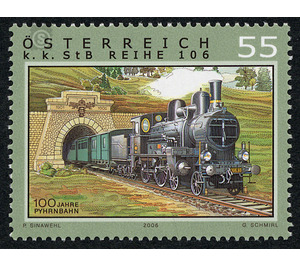100 years - Austria / II. Republic of Austria 2006 - 55 Euro Cent
Theme: Traffic, Transportation & Mobility
| Country | Austria / II. Republic of Austria |
| Issue Date | 2006 |
| Face Value | 55.00 |
| Edition Issued | 600,000 |
| Printing Type | combination printing |
| Stamp Type | Commemorative |
| Item Type | Stamp |
| Chronological Issue Number | 1944 |
| Chronological Chapter | OOS-OE2 |
| SID | 828406 |
| In 63 Wishlists | |
The Pyhrnpass with a height of 945 m is the lowest crossing of the Eastern Alps and frequented since the Neolithic period. In Roman times a post office led over this pass. In 1190 Bishop Otto II of Bamberg founded a hospice on the Pyhrn. With the advent of industrialization in particular of the iron processing in the Enns Valley and the scythe works in the Pyhrnregion thought in 1866 in the Linz Landtag to a rail link. The project was placed in favor of the "Kronprinz-Rudolf-Bahn" through the Ennstal. In 1880, the Kremstalbahn company was founded, which built a railway connection from Linz via Kremsmünster to Klaus-Steyrling. It was not until the beginning of 1901 that the legal basis for the realization of a railway line from Klaus to Selzthal was created as part of the state project "New Alpine Railways", which was planned to rescue the port of Trieste. Taking into account suitable gradient conditions, the Bosruck variant of the route over the Pyhrn was used for the alignment of the route. On 1 July 1901 the ground was broken in Spital am Pyhrn. Simultaneously with the tunnel construction also the supplying distances were built in the years 1903 to 1905 partly with substantial technical expenditure. Catastrophic flooding delayed the breakthrough of the 4770 m Bosruck Tunnel, whose opening was celebrated on 21 August 1906. The day before the opening, the last stagecoach drove the Pyhrn Pass. The 104 km long, single-track line of the Pyhrn Railway from Linz to Selzthal served until today primarily for freight traffic. Of course, it also brought tourism to flourish in the Pyhrn-Priel region. However, the railway remained a stepchild, because after the collapse of the monarchy and the disappearance of the Moravian region, the north-south connection was only of local importance. Between 1963 and 1965, the line had to be rehabilitated. Especially the Bosruck tunnel had suffered enormous damage from the steam operation and was closed for two years. Only in the years 1975 to 1977 was the electrification of the track. On the Pyhrnbahn track improvements are made on an ongoing basis. For freight transport z. For example, a new loop was built to the Westbahn, which brings a travel time reduction of 1.5 hours and represents a relief of the Linz station. The railway has just received an overpowering competition in recent years by the construction of the Pyhrnautobahn. So she lost her former status in the load transport. Although the Pyhrn Railway is part of the Trans-European Network, its further development is not the first priority.


